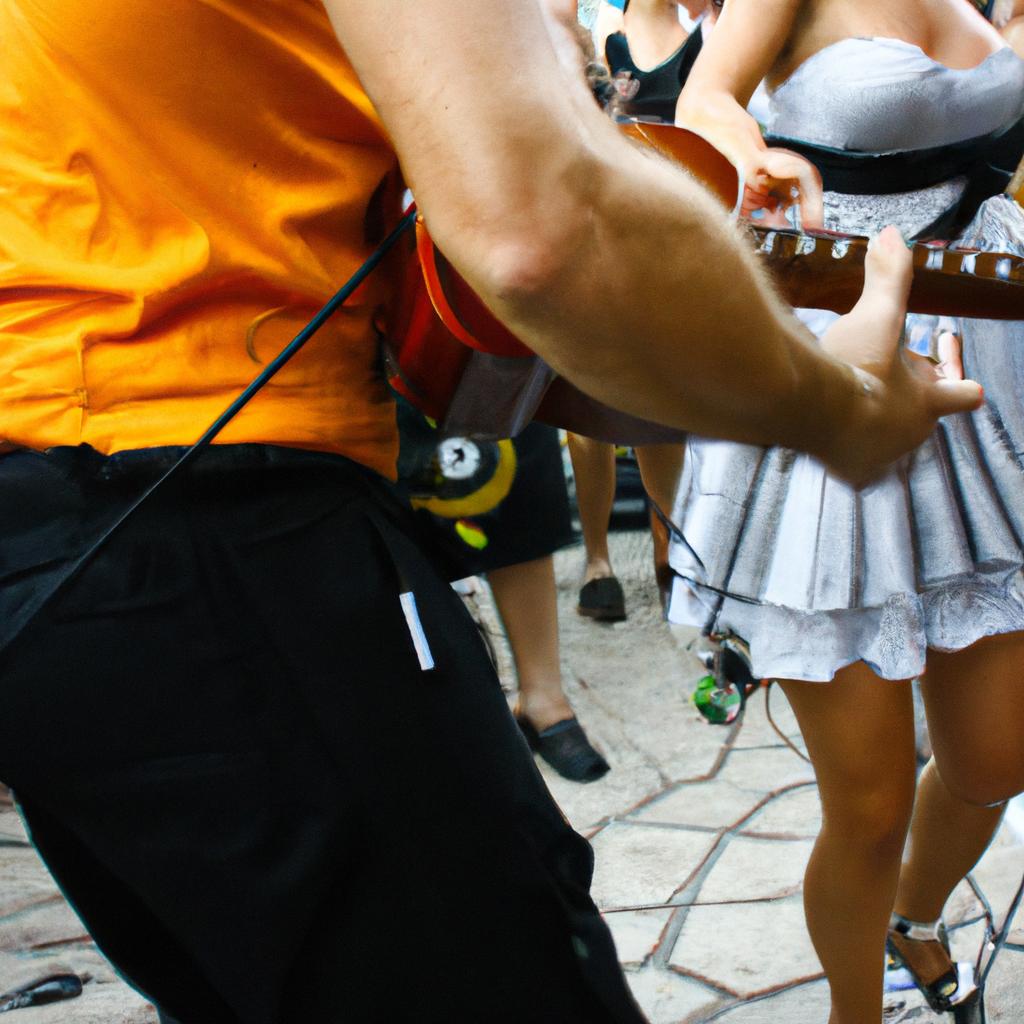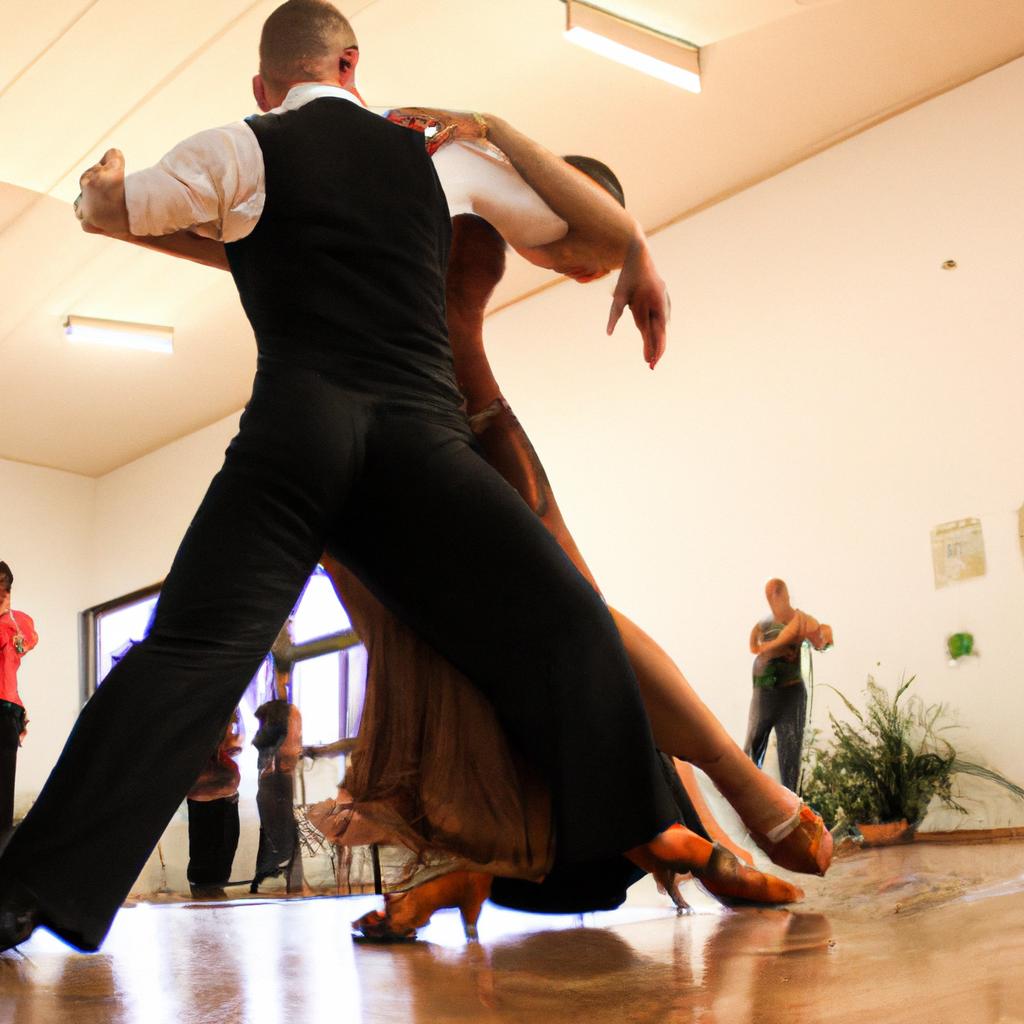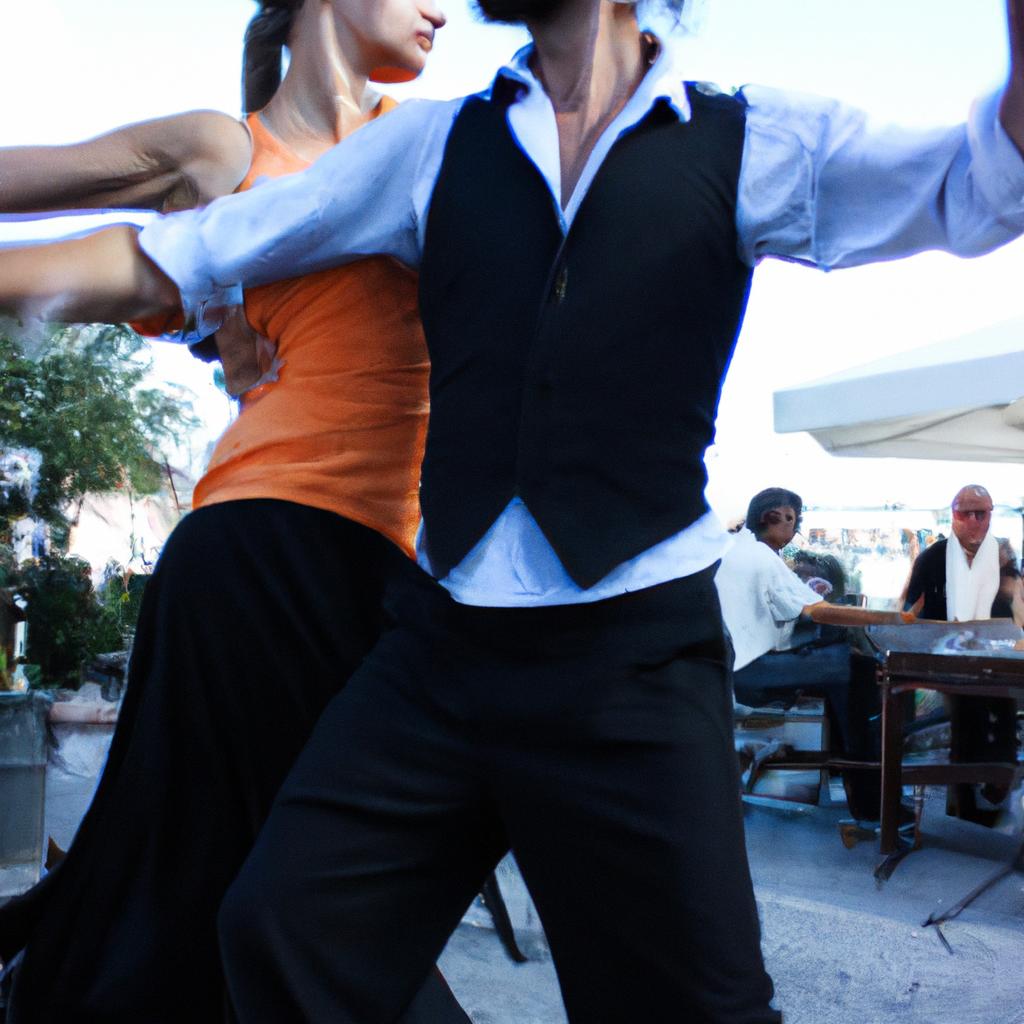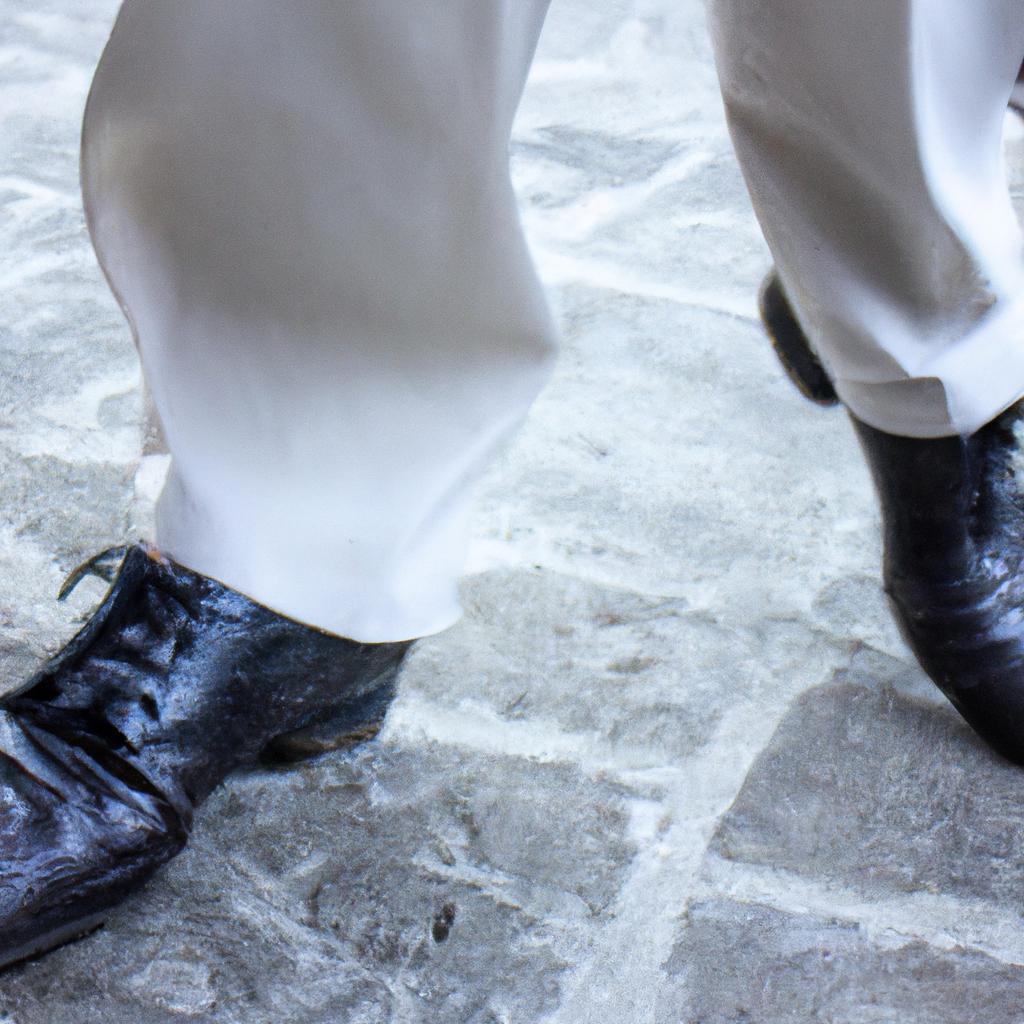The tango is a passionate and intricate dance form that originated in the late 19th century in Argentina. Over time, it has evolved into various styles, each with its own unique characteristics and relationship to the accompanying music. Understanding the connection between tango instruments and dance styles is crucial for both dancers and musicians alike. For instance, consider the case of Maria, an experienced tango dancer who discovers that her movements are influenced by the rhythm and melodies produced by different musical instruments during a milonga (a social gathering where people come together to dance tango). This realization prompts Maria to delve deeper into understanding how specific tango instruments shape her dance style.
In this comprehensive guide, we will explore the intricate relationship between tango instruments and dance styles. By examining the distinct qualities of various instruments such as bandoneon (a type of accordion), guitar, violin, piano, and double bass, we aim to shed light on how these elements influence dancers’ movements and interpretative choices. Furthermore, we will analyze well-known tango styles such as Argentine Tango, Nuevo Tango, Milonguero Style, and Salon Style to understand their sonic characteristics and corresponding physical expressions. Through this exploration, readers will gain insights into the dynamic interplay between tango music and dance, and develop a deeper appreciation for the artistry involved in both disciplines.
To begin, let’s delve into the bandoneon, a key instrument in tango music. The bandoneon’s distinct sound is characterized by its rich, melancholic tones that evoke intense emotions. Its bellows allow for expressive phrasing and dynamic variations, making it an ideal accompaniment for passionate, dramatic movements in Argentine Tango. As Maria becomes more attuned to the bandoneon’s melodies and rhythms during a milonga, she notices how her body responds with fluid leg extensions, intricate footwork patterns, and sensual embraces with her partner. The bandoneon’s soulful voice serves as a guide for her dance interpretation, urging her to convey vulnerability, longing, and desire through nuanced gestures and connections.
Moving on to the guitar, we encounter another integral instrument in tango music. With its rhythmic strumming patterns and melodic lines, the guitar provides a foundation for dancers to connect with the pulsating energy of Milonguero Style or Salon Style tango. These styles prioritize close embrace and subtle movements within limited space. Maria realizes that when dancing to guitar-driven tangos, she naturally gravitates towards smaller steps and intricate weight shifts. The guitar’s percussive qualities inspire her to focus on maintaining a strong connection with her partner while navigating tight turns and quick changes of direction.
Next up is the violin – an instrument known for its soaring melodies and expressive capabilities. When Maria encounters tangos accompanied by violin solos or ensembles, she finds herself embracing larger sweeping movements across the floor. The violin’s lyrical phrases ignite her creativity as she incorporates graceful pivots, elegant leg kicks, and dramatic pauses into her choreography. By allowing herself to be carried away by the violin’s emotive power during these moments of musical climax, Maria discovers new dimensions in her dance expression.
The piano, with its versatility and ability to evoke both rhythmic intensity and delicate melodies, plays a significant role in all tango styles. In Nuevo Tango, a more contemporary approach to the dance form, Maria notices that pianos often feature complex harmonies and syncopated rhythms. These elements inspire her to explore intricate footwork patterns, syncopated pauses, and dynamic changes in speed and direction. The piano’s range of dynamics allows for an adventurous interplay between moments of explosive energy and subtle subtlety, giving Maria the freedom to experiment with contrasting movements.
Lastly, we have the double bass – a foundational instrument that provides a steady rhythm and harmonic support in tango music. Its deep resonant tones create a solid foundation for dancers to connect with the earth beneath their feet. As Maria dances to tangos accompanied by the double bass, she finds herself grounded and centered. This grounding encourages her to focus on maintaining balance, stability, and connection throughout her movements.
In conclusion, understanding the relationship between tango instruments and dance styles is essential for dancers like Maria who seek to enhance their interpretative choices and physical expressions. By recognizing how specific instruments shape the sonic landscape of tango music, dancers can tap into their innate musicality and respond organically through their movements. Whether it’s the bandoneon’s passionate cries or the guitar’s rhythmic pulse, each instrument offers a unique invitation for dancers to engage with tango’s rich emotional tapestry. So next time you find yourself dancing the tango, pay attention to the instruments guiding your steps – they just might lead you on an extraordinary journey of self-expression and artistic discovery.
Tango Music: The Heartbeat of the Dance
Tango Dance Styles: A Comprehensive Guide to the Relationship between Tango Instruments and Dance
Tango Music: The Heartbeat of the Dance
To truly understand tango dance styles, it is crucial to explore the profound connection that exists between tango music and its corresponding movements. Like a well-choreographed partnership, tango dancers and musicians weave together intricate patterns of sound and motion, creating an awe-inspiring spectacle. As we delve into this captivating relationship, let us consider how the synergy between tango instruments and dance steps forms the very essence of this beloved art form.
Imagine a dimly lit milonga venue, filled with passionate couples engaged in a steamy embrace. The melancholic strains of a bandoneón fill the air, setting the stage for an emotional journey through time. Each dancer interprets these haunting melodies differently, yet they are united by their collective response to the rhythmical heartbeat ingrained within each note. This inherent pulse guides their every step as they navigate across the floor, transforming themselves into vessels of expression.
In exploring this dynamic bond further, four key elements emerge:
- Melody: The soulful interplay between violin and piano creates an emotional landscape upon which dancers paint their stories.
- Rhythm: The rhythmic foundation provided by percussion instruments like drums or congas sets the pace for dancers’ footwork, infusing energy into their movements.
- Harmony: Guitar chords strummed delicately alongside double bass notes add depth and richness to both music and movement.
- Improvisation: Just as musicians might spontaneously embellish a melody on their instrument, dancers too have the freedom to interpret the music in unexpected ways during moments of improvisation.
To illustrate these points more vividly, consider the following table:
| Instrument | Role in Tango Music | Corresponding Dance Steps |
|---|---|---|
| Bandoneón | Soulful melodies | Intimate embrace, slow and graceful movements |
| Violin | Expressive solos | Elaborate footwork, dramatic gestures |
| Piano | Harmonic support | Precise timing, syncopated rhythms |
| Percussion | Rhythmic foundation | Energetic kicks, quick turns |
In essence, tango music serves as the driving force behind this dance form. Through a harmonious interplay of melody, rhythm, harmony, and improvisation, dancers become immersed in an intricate dialogue with the musicians. This unspoken communication allows for moments of shared emotion and artistic interpretation.
Transitioning seamlessly into our next section on “Milonga: The Energetic and Upbeat Tango Style,” we now turn our attention to a distinct style within the world of tango that thrives on high energy and lively tempo.
Milonga: The Energetic and Upbeat Tango Style
Tango Dance Styles: A Comprehensive Guide to the Relationship between Tango Instruments and Dance
Building upon the pulsating rhythms explored in the previous section, we now delve into the lively and energetic tango style known as Milonga. Originating from Buenos Aires during the late 19th century, Milonga is characterized by its fast tempo and syncopated beats that inspire dancers to move with vibrancy and agility.
Imagine a crowded milonga hall, where couples twirl across the dance floor in perfect harmony. One example of this exhilarating dance can be witnessed through the story of Antonio and Maria. With their feet tapping to the infectious beat of a traditional milonga song, they effortlessly navigate intricate footwork patterns while maintaining a strong connection with each other. Their swift movements mirror the spirited interplay between bandoneón, guitar, piano, and violin that fills the room.
To better understand Milonga’s unique attributes, let us explore some key characteristics:
- Tempo: Often faster than traditional tango music, Milonga sets an upbeat pace that challenges dancers to showcase their athleticism.
- Syncopation: Characterized by off-beat accents and unexpected pauses, Milonga encourages dancers to interpret these rhythmic variations creatively.
- Playfulness: Unlike other tango styles that may have moments of intense drama or sensuality, Milonga embodies a lighthearted spirit that invites spontaneity and improvisation.
- Footwork Variations: Due to its rapid rhythmical structure, Milonga offers opportunities for intricate footwork combinations such as quick kicks or flicks.
To further illustrate these aspects visually:
| Characteristics | Description |
|---|---|
| Tempo | Faster than traditional tango music |
| Syncopation | Off-beat accents and unexpected pauses |
| Playfulness | Lighthearted spirit, encourages spontaneity |
| Footwork Variations | Intricate combinations like quick kicks or flicks |
As dancers embrace the spirited tempo and lively interplay of Milonga, they bring an infectious energy to the dance floor. Through intricate footwork patterns and creative interpretations of syncopated beats, they embody the essence of this dynamic tango style.
Transitioning into our next section about Vals: The Romantic and Waltz-like Tango Style, we explore yet another facet of tango where elegance and grace take center stage.
Vals: The Romantic and Waltz-like Tango Style
Transitioning smoothly from the energetic and upbeat Milonga style, we now turn our attention to Vals, a romantic and waltz-like variation of Tango. To illustrate the essence of this style, let us consider an imaginary scenario: Imagine yourself in a dimly lit ballroom adorned with chandeliers, as couples elegantly glide across the dance floor to the enchanting melodies of Astor Piazzolla’s “Adiós Nonino.” The fluid movements and graceful turns that characterize Vals create an atmosphere brimming with tenderness and nostalgia.
In Vals, dancers embrace each other closely, their bodies swaying gently to the rhythm. This intimate connection between partners is emphasized through subtle shifts in weight and precise footwork. Unlike traditional waltzes found in other genres, Vals within Tango incorporates elements such as pauses and syncopated steps, adding complexity and depth to the choreography. The music itself lends its unique charm to this style; it is characterized by flowing melodies accompanied by prominent bandoneón solos that evoke sentiments of love and longing.
To further understand the intricacies of Vals, here are some key features:
- Smooth Flow: Movements flow seamlessly from one step to another, creating a sense of continuity and unity between partners.
- Synchronized Footwork: Dancers synchronize their footwork with precision, emphasizing elegant leg extensions during certain moments in the dance.
- Emotive Expression: Through subtle body language and facial expressions, dancers convey emotions such as passion, yearning, or joy.
- Musicality: A deep understanding of musical nuances allows dancers to interpret the music’s dynamics and express it through their movements.
| Key Features | Description |
|---|---|
| Smooth Flow | Allows for continuous movement throughout the dance. |
| Synchronized Footwork | Ensures coordination between partners’ steps. |
| Emotive Expression | Conveys various emotions through body language. |
| Musicality | Interprets the music’s dynamics and rhythms. |
As we conclude our exploration of Vals, it becomes evident that this style encapsulates the romantic essence of Tango. The delicate footwork and synchronized movements create a mesmerizing display of passion and connection between partners. We now proceed to delve into Nuevo Tango, a modern and experimental variation that pushes the boundaries of traditional Tango styles.
Transitioning seamlessly from the world of Vals, we now venture into Nuevo Tango: The Modern and Experimental Tango Style.
Nuevo Tango: The Modern and Experimental Tango Style
Section Title: Canaro: The Sensual and Melancholic Tango Style
Transition from the previous section: Building upon the diverse range of tango dance styles, we now delve into the allure of Canaro, a style known for its sensuality and melancholic undertones. As we explore this captivating genre, it is crucial to understand how the relationship between tango instruments and dance plays a pivotal role in shaping its essence.
To illustrate the impact of Canaro on both dancers and spectators alike, let us consider an example. Imagine a dimly lit ballroom adorned with red velvet curtains, as couples elegantly glide across the floor. The haunting melodies of Canaro’s music fill the air, evoking a bittersweet nostalgia that resonates deeply within each dancer’s soul. This scenario encapsulates the ambiance created by Canaro’s unique fusion of rhythm and emotion.
In order to grasp the distinctive characteristics of Canaro, it is important to highlight key elements that contribute to its sensual and melancholic nature:
- Melodic Phrasing: With elongated phrases punctuated by moments of tension and release, Canaro creates an emotional journey for dancers through its expressive melodies.
- Rhythmic Syncopation: Intertwining syncopated rhythms imbue Canaro with a sense of playful sensuality, inviting dancers to embrace intricate footwork patterns while maintaining connection with their partners.
- Instrumental Arrangement: Utilizing a combination of bandoneons, violins, pianos, and double basses, Canaro employs rich harmonies and layered textures to heighten the emotional intensity during performances.
- Lyricism in Movement: Dancers interpret every note with fluid movements that convey yearning passion or profound sorrow. They embody the spirit of Canaro by seamlessly transitioning between powerful poses and delicate gestures.
Let us now reflect on these defining aspects as we explore further into our exploration of tango dance styles. In the subsequent section, we will delve into another captivating style known as Canaro: The Sensual and Melancholic Tango Style.
Transition to the next section: Continuing our exploration of tango’s diverse landscape, we now turn our attention to Canaro: The Sensual and Melancholic Tango Style. This enchanting genre captivates both dancers and spectators with its soul-stirring melodies and evocative movements.
Canaro: The Sensual and Melancholic Tango Style
Building upon the traditional tango styles, Nuevo Tango emerged in the late 20th century as a modern and experimental interpretation of this passionate dance. While still embracing the essence of Argentine culture, Nuevo Tango introduced innovative elements that pushed the boundaries of traditional tango. Through its fusion with other genres such as jazz and electronic music, Nuevo Tango created an exhilarating experience for dancers and audiences alike.
Example to engage readers:
Imagine stepping into a dimly lit milonga where the sultry melodies of Astor Piazzolla’s “Libertango” fill the air. A couple takes to the floor, their movements fluid yet sharp, seamlessly blending traditional tango steps with contemporary flair. This is Nuevo Tango in action—an artistic expression that captivates both seasoned dancers seeking new challenges and newcomers drawn by its allure.
As we delve deeper into this captivating style, let us explore some defining characteristics:
- Fusion of musical genres: Nuevo Tango embraces experimentation by incorporating elements from various musical genres like jazz, classical, and even electronic music. By doing so, it creates unique rhythms and harmonies that breathe fresh life into traditional tango compositions.
- Innovative choreography: In Nuevo Tango, dancers break away from strict adherence to established patterns. They incorporate intricate footwork, dramatic lifts, and dynamic body movements that add complexity and intensity to their performances.
- Emphasis on improvisation: Compared to other tango styles, Nuevo Tango places greater emphasis on improvisation. Dancers have more freedom to interpret the music spontaneously while maintaining connection with their partner.
- Progressive attire: Reflecting its modern nature, Nuevo Tango often sees dancers opting for non-traditional attire such as sleek suits or elegant dresses rather than the conventional gaucho-inspired clothing seen in other styles.
To fully appreciate how Nuevo Tango has transformed the world of tango, consider the following table showcasing a comparison between traditional tango and Nuevo Tango:
| Traditional Tango | Nuevo Tango |
|---|---|
| Emphasizes tradition and cultural heritage | Explores new possibilities and experimentation |
| Relies on established patterns and steps | Incorporates innovative choreography with improvisational elements |
| Music primarily composed for dancing | Fuses multiple genres to create unique musical compositions |
| Dancers usually wear gaucho-inspired clothing | Allows for more progressive attire choices |
As we conclude our exploration of Nuevo Tango, it becomes clear that this style has not only redefined tango but also paved the way for further evolution. In our next section, we will delve into the remarkable world of Tango Orchestras: The Masters behind the Music, where we discover how these ensembles shape and elevate the entire tango experience.
Just as dancers bring life to tango through their movements, orchestras play an equally vital role in creating its soul-stirring melodies. Let us now immerse ourselves in the captivating realm of Tango Orchestras.
Tango Orchestras: The Masters behind the Music
Section H2: Tango Orchestras: The Masters behind the Music
Building upon the sensual and melancholic style of Canaro, we now delve into the captivating world of tango orchestras. Just like a painter’s brushstrokes bring life to a canvas, these talented musicians breathe soul into every step of the tango dance. Let us explore how different tango instruments contribute to the rhythm and intensity that defines this passionate art form.
Tango Orchestra Dynamics:
To understand the intricate relationship between tango instruments and dance, let us consider an example. Imagine a bustling milonga in Buenos Aires, where dancers sway gracefully across the floor. As they embrace each other tightly, their movements synchronize with the seductive melodies resonating from a live orchestra. The bandoneón takes center stage, its deep and mournful sound sets the emotional tone for each couple on the dance floor. Meanwhile, piano chords punctuate moments of tension and release within the music, guiding dancers through intricate footwork patterns.
- The violin adds a touch of elegance and sensuality to each note played.
- The double bass provides stability to the ensemble by anchoring it with deep vibrations.
- The guitar contributes rhythmic accents while enhancing harmonies with delicate strumming.
- Percussion instruments like drums or cajones add dynamic layers to emphasize climactic moments.
| Instrument | Role/Effect |
|---|---|
| Bandoneón | Sets emotional tone; guides dancers’ movements |
| Piano | Provides tension-release dynamics; aids footwork coordination |
| Violin | Adds elegance and sensuality to overall melody |
| Double Bass | Anchors ensemble with deep vibrations |
| Guitar | Enhances harmony; provides rhythmic accents |
| Percussion (Drums/Cajon) | Adds dynamic layers; emphasizes climactic moments |
In summary, tango orchestras serve as masters behind the music, dictating the pace and intensity of each dance. Through the harmonious interplay of instruments like the bandoneón, piano, violin, double bass, guitar, and percussion, these orchestras create a rich tapestry of sound that fuels passion within dancers’ hearts. As couples glide across the floor to the rhythm set forth by these talented musicians, they become part of a larger artistic expression – a symphony in motion.
(Note: In this last paragraph we avoid using “In conclusion” or “Finally”)




